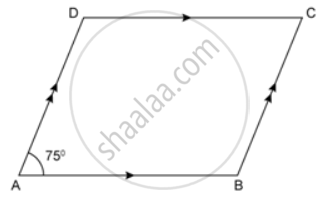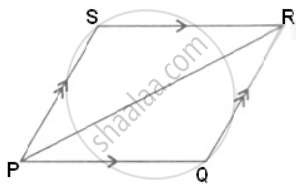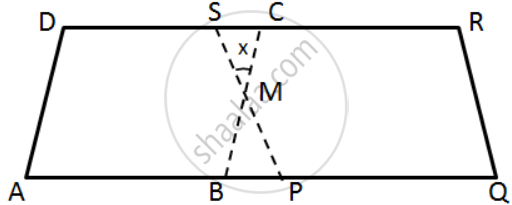Topics
Number Systems
Number Systems
Polynomials
Algebra
Coordinate Geometry
Linear Equations in Two Variables
Geometry
Coordinate Geometry
Introduction to Euclid’S Geometry
Mensuration
Statistics and Probability
Lines and Angles
- Introduction to Lines and Angles
- Basic Terms and Definitions
- Intersecting Lines and Non-intersecting Lines
- Introduction to Parallel Lines
- Pairs of Angles
- Parallel Lines and a Transversal
- Angle Sum Property of a Triangle
Triangles
- Concept of Triangles
- Congruence of Triangles
- Criteria for Congruence of Triangles
- Properties of a Triangle
- Some More Criteria for Congruence of Triangles
- Inequalities in a Triangle
Quadrilaterals
- Concept of Quadrilaterals
- Properties of a Quadrilateral
- Types of Quadrilaterals
- Another Condition for a Quadrilateral to Be a Parallelogram
- Theorem of Midpoints of Two Sides of a Triangle
- Property: The Opposite Sides of a Parallelogram Are of Equal Length.
- Theorem: A Diagonal of a Parallelogram Divides It into Two Congruent Triangles.
- Theorem : If Each Pair of Opposite Sides of a Quadrilateral is Equal, Then It is a Parallelogram.
- Property: The Opposite Angles of a Parallelogram Are of Equal Measure.
- Theorem: If in a Quadrilateral, Each Pair of Opposite Angles is Equal, Then It is a Parallelogram.
- Property: The diagonals of a parallelogram bisect each other. (at the point of their intersection)
- Theorem : If the Diagonals of a Quadrilateral Bisect Each Other, Then It is a Parallelogram
Circles
Areas - Heron’S Formula
Surface Areas and Volumes
Statistics
Algebraic Expressions
Algebraic Identities
Area
Constructions
- Introduction of Constructions
- Basic Constructions
- Some Constructions of Triangles
Probability
Notes
The opposite angles of a parallelogram are of equal measure.
Given: ABCD is a parallelogram.
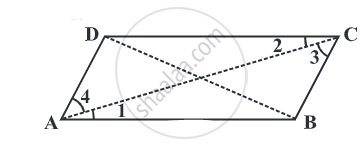
To Prove: m∠ A = m∠C
Construction: Draw diagonal AC and diagonal BD.
To Prove:
AC and BD are the diagonals of the parallelogram,
∠ BAC = ∠ ACD and ∠ DAC = ∠ ACB......(pair of alternate angles) and `bar(AC)` is common side,
In ΔABC and ∆ADC,
∠ BAC = ∠ ACD ......(pair of alternate interior angles)
∠ DAC = ∠ ACB ......(pair of alternate interior angles)
Side AC = Side AC ......(common side)
∆ABC ≅ ∆CDA ......(ASA congruency criterion)

This shows that ∠B and ∠D have same measure. In the same way you can get, m∠A = m ∠C.
Alternatively, ∠ BAC = ∠ ACD and ∠ DAC = ∠ ACB
We have, m∠ A = ∠ BAC + ∠ DAC and ∠ ACB + ∠ ACD = m∠C.
m∠A = m ∠C.
Hence Proved.
Example
In the given Fig, BEST is a parallelogram. Find the values x, y, and z.
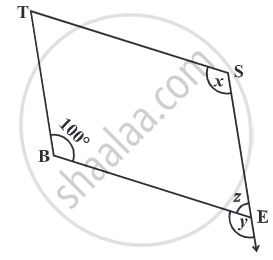
S is opposite to B.
So,
x = 100° ........(opposite angles property)
x = 100° ........(opposite angles property)
y = 100° ..........(a measure of angle corresponding to ∠ x)
z = 80° ..........(since ∠y, ∠z is a linear pair)
If you would like to contribute notes or other learning material, please submit them using the button below.
Shaalaa.com | To Prove that the Opposite Angles of a Parallelogram are equal in measure
to track your progress
Series: Property: The Opposite Angles of a Parallelogram Are of Equal Measure.
0%

